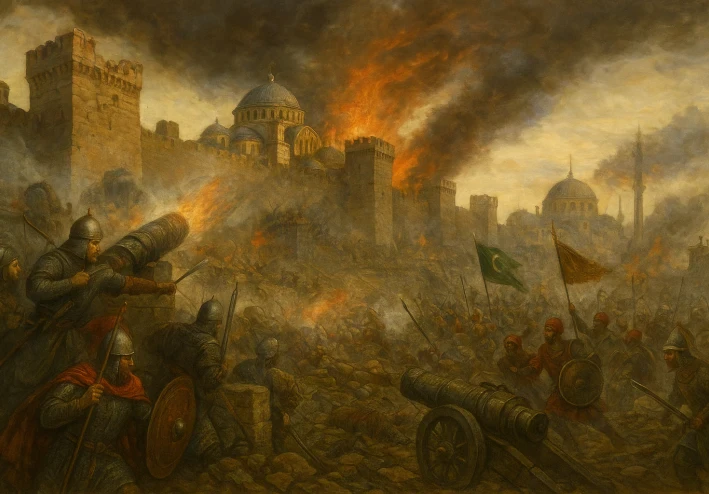
The Fall of the Byzantine Empire: The Siege of 1453
The Fall of the Byzantine Empire: The Siege of 1453
In the spring of 1453, the world stood on the brink of transformation. For over a thousand years, the Byzantine Empire had been a beacon of culture, faith, and power in the Eastern Mediterranean. Its capital, Constantinople, with its towering walls and shimmering domes, had withstood countless assaults. Yet, beneath its grandeur, the empire had grown fragile, weakened by centuries of wars, internal strife, and dwindling resources. Across the Bosporus, a new power was rising—the Ottoman Empire, led by the ambitious young Sultan Mehmed II.

Mehmed, only 21 years old, had set his eyes on Constantinople, determined to fulfill what his predecessors had failed to achieve. The city was the key to controlling trade between East and West and the symbolic heart of Christendom in the East. To take it would be to secure immortality in history.
In April 1453, Mehmed marched with a massive army of nearly 80,000 men, supported by a formidable naval fleet. More terrifying than the numbers was his use of massive cannons, crafted by Hungarian engineer Orban. These great bombards, capable of hurling stone balls weighing hundreds of pounds, threatened to do what no enemy had managed before—breach the mighty Theodosian Walls, the city’s legendary defenses.
Inside Constantinople, Emperor Constantine XI Paleologus prepared for what he knew could be the empire’s final stand. With barely 7,000 defenders, including a few thousand foreign allies—most notably the Genoese commander Giovanni Giustiniani—the odds were hopeless. Still, the emperor inspired his people with courage, reminding them that they defended not only a city but also their faith and heritage.
For weeks, the Ottomans bombarded the walls, shaking the ancient stones and the morale of those inside. Yet, the Byzantines resisted fiercely. Greek fire, counter-mines, and desperate sorties kept the attackers at bay. Each day became a test of endurance, faith, and will. The defenders clung to the hope that Western Europe would send aid, but none came.
As May drew to a close, Mehmed launched his final assault. On the night of May 28th, churches filled with worshippers, candles glowing as hymns echoed across the city. Men, women, and children prayed for deliverance, knowing that dawn would decide their fate.
At sunrise on May 29th, the Ottomans attacked with relentless fury. Waves of soldiers hurled themselves at the walls, battered by cannon fire. Giustiniani fought bravely but was wounded, leaving the defenders leaderless. The Ottomans poured through breaches in the walls, overwhelming the exhausted Byzantines. Emperor Constantine XI, refusing to flee, cast aside his crown and charged into the fray, vanishing amidst the chaos. His body was never found, but his courage became legend.
By midday, the city had fallen. The Hagia Sophia, once the greatest church in Christendom, was transformed into a mosque. The Byzantine Empire, which had endured since the days of Rome, was no more. Mehmed II, now known as “the Conqueror,” made Constantinople the new capital of his empire, renaming it Istanbul. The fall of the city shocked Europe, marking the end of the Middle Ages and heralding the dawn of a new era dominated by the Ottomans.
Yet, the story of Constantinople’s fall was more than one of conquest. It was a tale of resilience, of a small band of defenders who fought against impossible odds, and of the enduring legacy of a civilization whose culture, art, and faith would continue to influence the world for centuries.




































